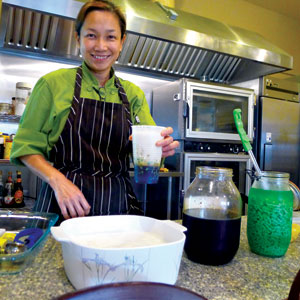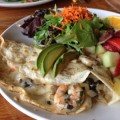For the past 30 years, downtown Saratoga has been known for its fancy, candlelit restaurants, places like the Plumed Horse, Le Mere Michele, Le Mouton Noir and Sent Sovi. But times change, and downtown Saratoga isn’t what it once was. Dwindling foot traffic and the city’s failure to do much about the growing number of vacancies along Big Basin Way have changed downtown into sleepytown.
But maybe the city’s do-nothing policy is doing something after all. Downtown isn’t dying. It’s evolving. I don’t know if it’s a decrease in commercial rents or changing demographics or both, but mixed in among the empty storefronts one now sees a growing diversity on Saratoga’s restaurant row.
Restaurants like Rose International Market (Persian), Casa de Cobre (Mexican) and Hachi Ju Hatchi (Japanese) represent a new wave of restaurants you wouldn’t have encountered 10 years ago. My favorite of the newcomers is 3-month-old Indo Cafe.
Indo Cafe is the most un-Saratoga restaurant in Saratoga, at least by the old standards. For one, it’s not even visible on Big Basin Way. It’s behind the UPS store across from the tumbleweed-blown Buy and Save shopping center. You have to drive between Ristorante di Mario and Rose International Market buildings and park in back to find it, and even then it’s a bit of a search your first time. The place itself isn’t even really a restaurant. It’s a commercial catering kitchen that happens to have two communal tables.
I hesitate to heap praise on the restaurant, because it’s so dang small—12 chairs small. But with food this good and people so nice, praise must be heaped. Maria Handayani runs Indo Cafe with the help of boyfriend Rick Horwege. Handayani, who is from East Java, is a surprisingly cheerful presence in the kitchen in spite of the hours she works. She’s there everyday, cooking for a growing number of restaurant and catering customers well into the early-morning hours.
But she’s not afraid of hard work. Before she came to the United States in 1985 to flee an arranged marriage and deadbeat husband, she ran a catering business, a beauty salon and a dog kennel all out of her home. In the United States, she worked in the bakery department at large supermarkets before starting a career in the financial-services industry for companies like New York Life, Morgan Stanley and the dreaded Countrywide Financial. When that industry started to crumble, she fell back on her skills as a cook, an ability she credits to her grandmother.
“I came back full circle to cooking,” she says. “I love it. It’s more relaxing for me. It’s better than working for a corporation that is only concerned about profit.”
Sitting in the restaurant is like pulling up a chair in a big open kitchen. I began to feel like I was in Handayani’s home watching her cook. You’re free to get up and watch what she’s doing and get a quick lesson in Indonesian cooking. Apparently Indonesian college students at nearby universities have discovered her cooking and have become some of her best catering customers. She was readying a big order for them while cooking for my party and a few Indonesian expats who wandered in later. One brought in a few fiery-looking thin chiles, looking for her to use them.
Handayani says she makes everything by hand. There are few appliances in the kitchen, and she seems to get the most use out of an Indonesian version of a mortar and pestle, a shallow wooden bowl with a right-angled pestle for grinding spices, roots and herbs.
What’s good here? Everything I tried. The menu is brief, just five rice plates that reflect regional variations of the island nation of Indonesia. Indonesian food is similar to Thai or Malaysian food but is really a cuisine unto itself.
While I waited, Handayani was making potato croquettes, chubby, patties of mashed potatoes stuffed with seasoned ground beef and rolled in panko, Holland’s gift to Indonesia. The patties are fried and served with what I think is the best peanut sauce I’ve ever had. The sauce is made with fresh-roasted peanuts, salt, sugar, chiles and vinegar. It’s not runny and overly sweet. She makes the croquettes for the Big Basin Cafe down the street, so she says she doesn’t want to sell them herself and undercut the cafe, but she let us have a complementary sample.
I loved the yogyakarta rice combo ($7.99), a hungry-person sampler plate that includes young jackfruit, a light, pale yellow curry. The tropical fruit is picked early and has a texture like artichokes hearts. The plate includes thick battered boiled eggs in wonderful red chile-spiked sambal and curry-laced fried tofu.
The Padang rice plate ($7.99) is a standout for its 24-hour braised rendang beef. The beef shoulder verges on too dry, but the deep, velvety marinade/sauce served with it keeps any dryness in check. The gulai chicken served along with it, tender, on-the-bone chicken swaddled in a coconut milk, ginger and lemongrass sauce/paste, is excellent, too. Various sauces and condiments add additional notes and flavors, and pretty soon it’s all mixed up and still just as good.
Drinks are limited to soda pop, bottled water and Indonesian tea. I’ll have to come back to try dessert. Handayani says she does a lot of catering for weddings, making Indonesian wedding cakes and pastries. If I can find a space at the table, that is. Otherwise you’ll find me eating in my car in the parking lot out back.

 San Jose Youth Symphony
San Jose Youth Symphony  Live Feed: A New Low
Live Feed: A New Low 


